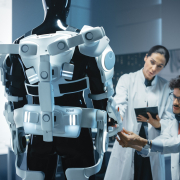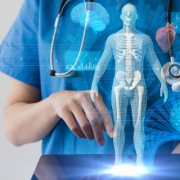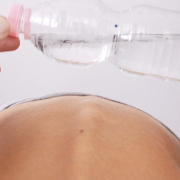Intelligenza artificiale: quale rivoluzione nel trattamento riabilitativo?
L’Intelligenza Artificiale (IA) sta trasformando il modo in cui i medici affrontano la riabilitazione, offrendo strumenti innovativi che migliorano la qualità dei trattamenti. In ISICO siamo sempre più impegnati a esplorare come l’IA possa supportare il lavoro clinico quotidiano e contribuire a decisioni terapeutiche sempre più personalizzate.
Ne abbiamo parlato con il dr. Francesco Negrini, fisiatra specialista di ISICO, autore nel 2023 della ricerca su AI e riabilitazione che si è aggiudicata il SOSORT AWARD (Developing a new tool for scoliosis screening in a tertiary specialistic setting using artificial intelligence: a retrospective study on 10,813 patients: 2023 SOSORT award winner). Negrini ha di recente presentato un’altra relazione su IA e progetti di utilizzo nella riabilitazione dello Stroke.
Quali sono gli ambiti principali in cui l’IA può essere utilizzata nella riabilitazione?
L’IA è incredibilmente versatile. Può essere difatti applicata in molte fasi del processo medico: dalla diagnosi, attraverso l’analisi automatizzata di immagini radiografiche o RM per identificare patologie con maggiore precisione, alla prognosi, con previsioni sui risultati dei trattamenti, fino alla personalizzazione dei trattamenti, per determinare il percorso terapeutico più efficace basato sui dati del paziente e al monitoraggio continuo, così da valutare in tempo reale i progressi del paziente per adattare il trattamento. In ISICO, per esempio, stiamo studiando come l’IA possa supportare la personalizzazione del trattamento. Con questa tecnologia si potrebbero analizzare la storia naturale del paziente e le probabilità di successo nell’utilizzo di un corsetto rispetto a un altro, fornendo al medico strumenti decisionali più accurati.
Ci può fare un esempio concreto di come ISICO sta utilizzando l’IA?
Un esempio significativo è la ricerca premiata con il SOSORT Award 2023, pubblicata recentemente. Lo studio ha dimostrato come l’analisi dei dati clinici attraverso tecniche avanzate possa migliorare la comprensione della scoliosi e dei suoi trattamenti. Un altro possibile utilizzo riguarda la diagnosi della lombalgia, dove l’IA può analizzare immagini radiografiche per identificare eziologie che altrimenti potrebbero sfuggire all’occhio umano. Questo approccio sfrutta la maggiore potenza di calcolo disponibile oggi, che permette di processare grandi quantità di dati in modo rapido e accurato.
Come l’IA potrebbe cambiare la gestione delle patologie vertebrali in futuro?
Ci sono tre aree chiave in cui vediamo un enorme potenziale: screening e diagnosi precoce che significa rilevare la scoliosi o altre condizioni in una fase iniziale, migliorando gli esiti del trattamento; personalizzazione dei corsetti, ossia utilizzare i dati raccolti nei centri clinici per prevedere quale tipo di corsetto sarà più efficace per un determinato paziente; monitoraggio dei risultati, così da tracciare l’andamento della terapia e adattarla in base ai progressi osservati, migliorando l’efficacia del trattamento.
Cosa rende l’AI un alleato così prezioso per i clinici?
L’IA amplifica le capacità del clinico, fornendo informazioni più dettagliate e aiutandolo a prendere decisioni basate sui dati. Tuttavia, come sottolineiamo sempre in ISICO, il rapporto medico-paziente rimane centrale. L’IA non sostituisce l’esperienza e l’empatia del medico; piuttosto offre strumenti che migliorano il lavoro umano.
Qual è il futuro dell’IA in medicina riabilitativa?
Credo che vedremo un’integrazione sempre più stretta. In ISICO ci stiamo muovendo in questa direzione, esplorando come utilizzare l’IA per migliorare i risultati terapeutici e rendere la riabilitazione più mirata. Siamo solo all’inizio, ma le possibilità sono enormi, soprattutto se riusciamo a combinare il meglio della tecnologia con la preziosa competenza umana.






